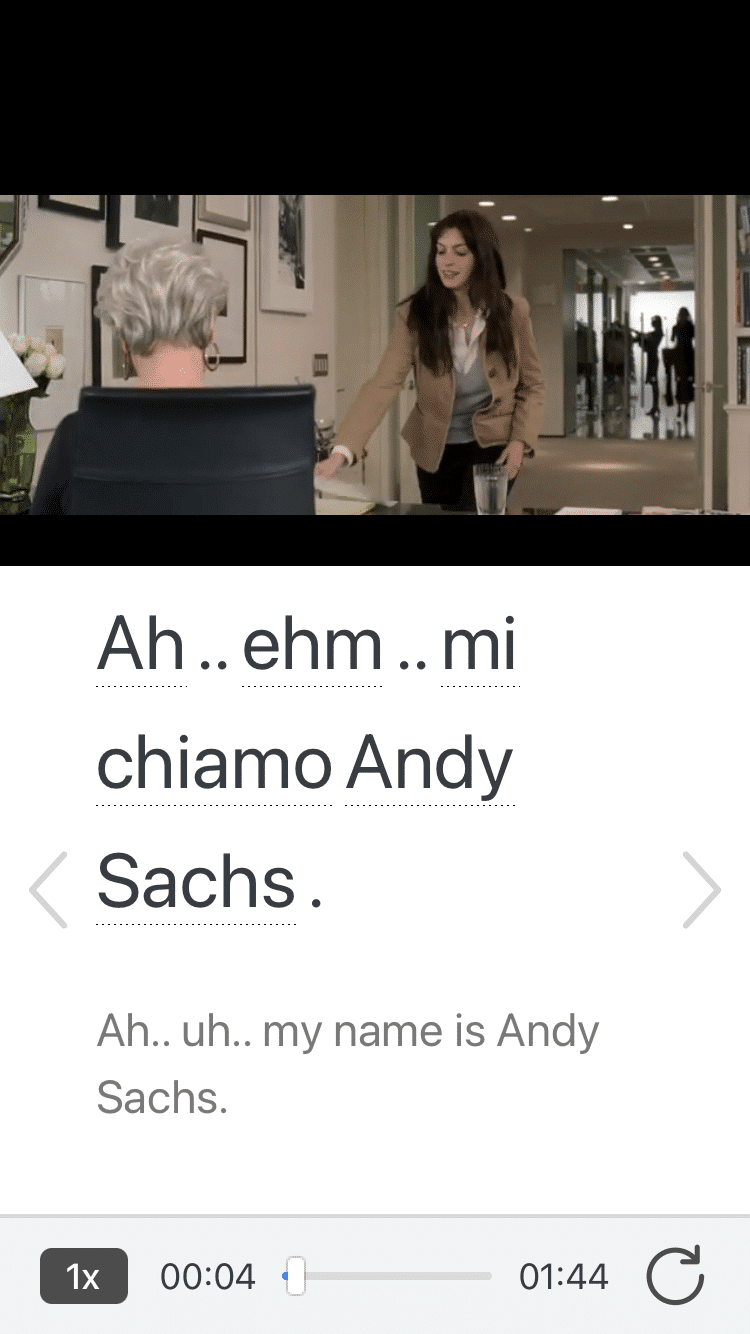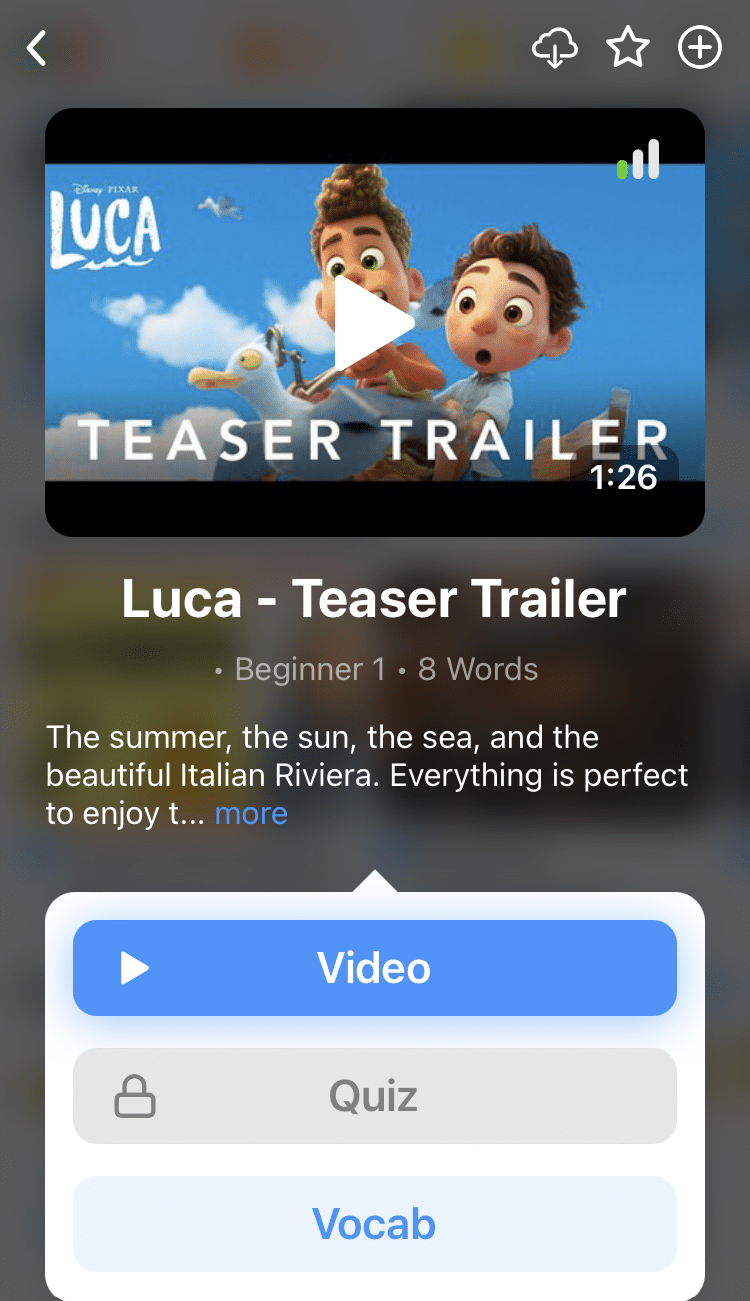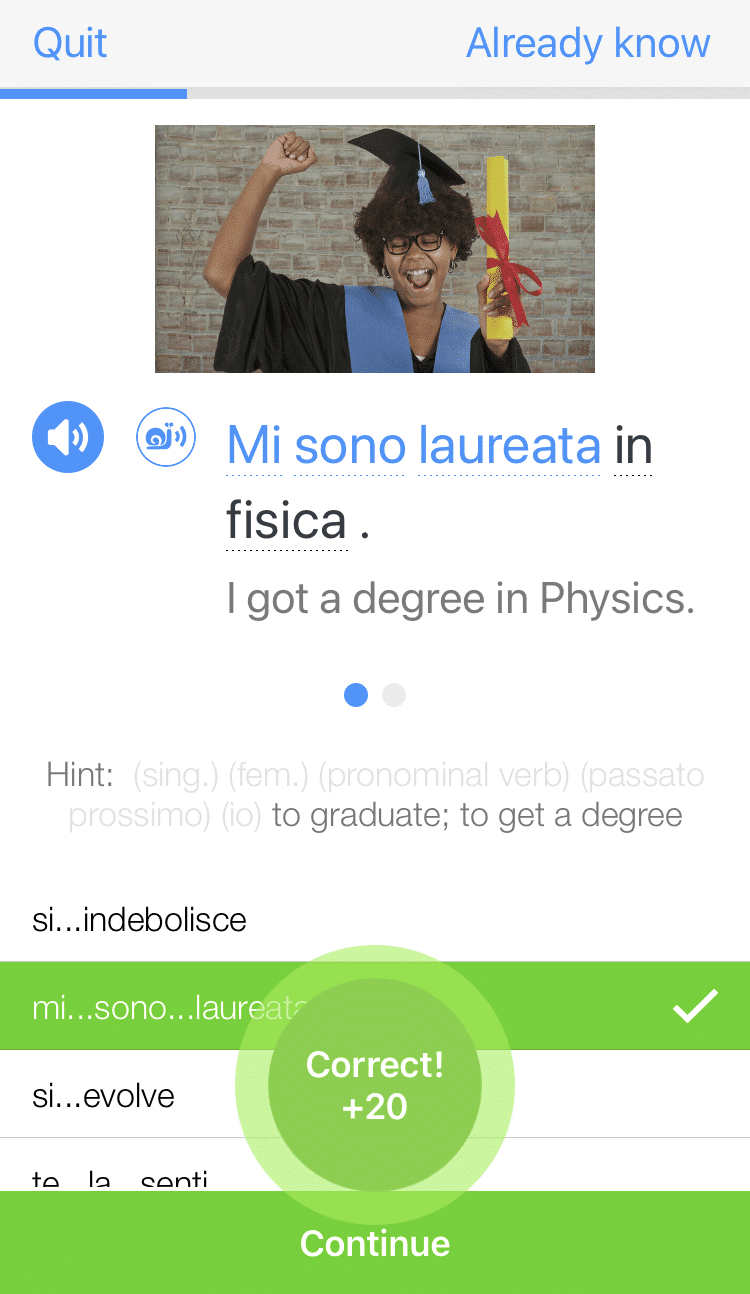
Italian Past Tense: A Comprehensive Guide
Whether you’re a beginner or an advanced learner, it can be challenging to use different Italian past tenses, but I’ll teach you how to do it with confidence.
In this blog post, you’ll find an overview of the Italian past tenses with real-life examples, verb conjugations, and audio to help you memorize how to use each tense with ease.
So, let’s dive in!
Contents
- The Italian Perfect Past Tense: Il Passato Prossimo
- The Italian Imperfect Past Tense: L’Imperfetto
- The Italian Pluperfect Past Tense: Il Trapassato Prossimo
- The Italian Past Subjunctive Moods
- The Italian Simple Past Tense: Il Passato Remoto
- And One More Thing...
Download: This blog post is available as a convenient and portable PDF that you can take anywhere. Click here to get a copy. (Download)
The Italian Perfect Past Tense: Il Passato Prossimo
The passato prossimo (recent past) tense is used to talk about events that took place and were completed at a moment in the past. For example:
Sono andato in Sardegna. — I went to Sardinia.
It can also be used like the present perfect in English to talk about a past that continues into the present.
Sono sempre andato in Sardegna. — I have always gone to Sardinia.
To form the passato prossimo, you’ll need one of two auxiliary (helper) verbs: avere (to have) and essere (to be).
Their conjugations are as follows:
Avere
| Pronoun | Pefect Past Tense |
|---|---|
| io (I) | ho |
| tu (you) | hai |
| lui / lei (he / she) | ha |
| noi (we) | abbiamo |
| voi (you all) | avete |
| loro (they) | hanno |
Essere
| Pronoun | Pefect Past Tense |
|---|---|
| io (I) | sono |
| tu (you) | sei |
| lui / lei (he / she) | è |
| noi (we) | siamo |
| voi (you all) | siete |
| loro (they) | sono |
But which of these helpers should you choose?
That’s a complex question, and the answer depends on the main verb that these verbs are trying to “help.” You often have to learn whether to use avere or essere on a case-by-case basis, but there are some general guidelines.
Use avere: For most transitive verbs (verbs that take an object), such as dire (to say) or comprare (to buy)
Use essere: For most intransitive verbs (verbs that do not take an object), such as svenire (to faint) or morire (to die)
Use essere: For all reflexive verbs, like alzarsi (to stand up)
Use essere: For many verbs of motion, like andare (to go)
If you really wanted to, you could memorize a basic list of which common verbs take essere, as there are fewer of those, but it’s probably more convenient to just learn the general rules above, and then note the exceptions as they come up when you’re learning new verbs.
You can familiarize yourself more with this concept by watching how native speakers use this tense in various scenarios. For example, the FluentU program has an array of Italian videos that you can use to study this tense in a natural context.
FluentU takes authentic videos—like music videos, movie trailers, news and inspiring talks—and turns them into personalized language learning lessons.
You can try FluentU for free for 2 weeks. Check out the website or download the iOS app or Android app.
P.S. Click here to take advantage of our current sale! (Expires at the end of this month.)
Note that there are also some verbs that take both avere and essere, depending on their use. In these cases, the transitive use gets avere and the intransitive use gets essere.
You can see this happen for example with passare, which can be used to talk about passing time (transitive use) or passing by (going) somewhere (intransitive use).
Oggi ho passato tutto il giorno qua. — Today I have spent all of the day here.
Oggi sono passato al mercato a comprare il pesce. — Today I passed by the the market to buy fish.
Next, you need to get a conjugation of your main verb, which is the past participle.
For regular verbs that work with avere, you’ll remove the ending from the infinitive and replace it with one of three endings to get the past participle:
–are verbs: –ato
–ere verbs: –uto
–ire verbs: –ito
Here these are in action, with the verbs parlare (to speak), ricevere (to receive) and dormire (to sleep):
Ho parlato con lei ieri. — I spoke with her yesterday.
Ho ricevuto il premio d’italiano. — I received the prize for Italian.
Ho dormito bene questa notte. — I slept well last night.
Regular verbs that work with essere get the same endings, but they’re then modified much as you would expect from what you’ve seen with the agreement of Italian adjectives. The agreement of the past participle is with the subject of the verb (the person doing something).
So in the first example in this section, sono andato, you know that the person speaking (and going somewhere) is one male; he would say sono andata if he were a female. The past participle of the verb andare also changes if two or more people are going somewhere.
Siamo andati in Italia quest’estate. — We (a group that has at least one male) went to Italy this summer.
Siamo tornate dalla Svizzera da due settimane. — We (a group of females) returned from Switzerland two weeks ago.
Here are some examples of other verbs used in the passato prossimo with essere.
Sono nato negli Stati Uniti. — I (male) was born in the United States.
Lui è morto l’anno scorso. — He (male) died last year.
Vi siete mascherati per il carnevale in poco tempo! — You (group with at least one man) got dressed up for the carnival in little time!
Ci sono voluti tre anni per imparare il serbo. — It took three years to learn Serbian. (Note that voluti agrees with anni, which is the grammatical subject.)
Ti sei già alzata! — You (female) have already gotten up!
Anna e Paola si sono divertite al bar. — Anna and Paola had a good time at the bar.
There are also many irregular past participles to learn; be particularly suspicious of –ere verbs as they are the most frequently irregular. Here are a few examples of irregular past participles.
Melania ha rotto la sedia. — Melania broke the chair.
Il fantasma è apparso all’improvviso. — The ghost appeared all of a sudden.
Lui è venuto alla festa perché non ha vergogna. — He came to the party because he is shameless.
Another wrinkle in the formation of the past participles is that in certain cases they’ll also be modified for agreement when you’re using the helper verb avere. This happens when the verb has a direct object pronoun (mi, ti, lo, la, l’, ci, vi, li, le); the participle is then modified to agree with the direct object. For example:
Hai visto la email? — Have you seen the email?
Si, l’ho vista. — Yes, I’ve seen it.
If you’ve also studied French, be aware that Italian is a bit different in that this only happens with pronouns, and never with direct object nouns:
Questa è la email che ho visto. — This is the email that I have seen.
It’s very important to note that this modification does not take place in the case of indirect object pronouns with avere.
Hai chiesto a lei? — Did you ask her?
Si, le ho chiesto. — Yes, I asked her.
And finally, what do you do with modal verbs (when you’ve got two verbs stuck together), as happens with dovere or potere (to be able to)?
For example, which of the following is best?
L’anno scorso sono potuto andare in Italia due volte. — Last year I was able to go to Italy twice.
L’anno scorso ho potuto andare in Italia due volte. — Last year I was able to go to Italy twice.
The answer: it’s complicated.
Italian is always on the move and this is an area where the language is currently in a particularly awkward state of flux. Stodgier speakers (say, older Italian teachers) may tell you that you should use whatever auxiliary would be demanded by the main verb, and not by the modal verb (so sono, in the example above). But more often now speakers and even Italian teachers consider it correct to just use avere.
Here’s another example in which either one could be considered correct, depending on whom you ask:
Mi sono dovuta alzare alle 10:00. — I (female) had to get up at 10:00.
Ho dovuto alzarmi alle 10:00. — I (female or male) had to get up at 10:00.
Just note that when using avere in the second case, the pronoun mi must be placed after the verb, and that there’s no agreement shown in the past participle. With essere, there is agreement and the pronoun is in front.
The Italian Imperfect Past Tense: L’Imperfetto
The hazier, not-necessarily-finished past is expressed in Italian with the imperfect tense. It sometimes corresponds to English constructions like we used to dance or we were dancing.
The conjugations for regular -are verbs into the imperfect involve removing that ending and adding an ending that corresponds to the subject.
| Pronoun | Imperfect Past Tense |
|---|---|
| io (I) | -avo |
| tu (you) | -avi |
| lui / lei (he / she) | -ava |
| noi (we) | -avamo |
| voi (you all) | -avate |
| loro (they) | -avano |
The spoken stress falls on the penultimate syllable except for the loro form, in which it falls on the third from last syllable.
Regular verbs ending in –ere are the same except that the initial a in the ending is replaced with an e; likewise with –ire verbs, in which that a is replaced with an i.
For example, if I want to use the verb vivere (to live), and talk about myself, I get the conjugation: vivevo (I was living / I used to live).
Here it is in a sentence:
Vivevo a New York quando è successo l’attacco delle torri. — I was living in New York when the attack on the towers happened.
This sentence also cleanly demonstrates the difference between the imperfect (vivevo) and the passato prossimo (è successo).
The imperfect is used to talk about a hazy (undefined beginning and ending) past that sets the scene, whereas the passato prossimo discusses what the speaker feels is more of a completed moment in time.
There are also, unfortunately, irregular verbs in the imperfect. At first you’ll want to at least know the imperfect conjugations of essere (to be):
| Imperfect conjugations of essere (to be) | |
|---|---|
| io (I) | ero |
| tu (you) | eri |
| lui / lei (he / she) | era |
| noi (we) | eravamo |
| voi (you all) | eravate |
| loro (they) | erano |
Also beware of irregulars cropping up as usual with the Italian contracted infinitives, and learn these imperfect irregular conjugations as you learn new verbs.
To contrast the use of the imperfect with the use of the passato prossimo, it helps to look at many examples, keeping in mind that the imperfect suggests “the way things were” or “used to be.” The imperfect is for setting a scene, habitual actions and states of affairs.
The passato prossimo, on the other hand, comes into play for points in time and actions that are continued into the present.
Compare the following two sentences, which might be translated the same in English but have different meanings to an Italian.
Eravamo felici di vedervi. — We were happy to see you. (You—used to, in a vague, undefined past period—be here with us. Those were some good times, huh?)
Siamo stati felici di vedervi. — We were happy to see you. (You are leaving now, and we’re saying we just had a nice moment together.)
So if I want to set a scene for a story, I’m definitely going to use the imperfect:
C’era una volta… — Once upon a time…
The Italian Pluperfect Past Tense: Il Trapassato Prossimo
The pluperfect, or trapassato prossimo, is used to talk about actions that had happened before some other thing happened in the past. In English, you usually see this idea expressed with the word “had.”
To form the trapassato prossimo, you simply take the imperfect form of avere or essere and then add the past participle of the main verb.
Here are some examples in context:
La mia vita era stata bella finché ho conosciuto Raffaella. — My life had been beautiful until I met Raffaella.
Avevamo fatto molte ricerche prima di comprare il biglietto. — We had done a lot of research before buying the ticket.
Note that in the first example, we might well say “was” instead of the pluperfect “had been,” but Italian is more steadfast in its use of the pluperfect in past-before-the-past situations.
The Italian Past Subjunctive Moods
The past subjunctive moods are used quite similarly to the present subjunctive mood to indicate feelings about past events, or to set up a discussion of a hypothetical state of affairs.
The formation of the perfect subjunctive takes the subjunctive form of the auxiliary verb avere or essere (according to the same rules in the first section), plus the past participle of the main verb.
Sono felice che siano partiti. — I’m happy they left.
Here siano is the subjunctive of essere and partiti is the past participle. The first part of the sentence is in the normal passato prossimo.
The imperfect subjunctive is the subjunctive mood that corresponds to the imperfect. It has these endings for –are verbs:
| Pronoun | Imperfect Past Tense |
|---|---|
| io (I) | -assi |
| tu (you) | -assi |
| lui / lei (he / she) | -asse |
| noi (we) | -assimo |
| voi (you all) | -aste |
| loro (they) | -assero |
The regular verb endings for –ere follow the same pattern but have endings beginning with e, and the –ire verbs do likewise but begin with i.
In addition to expressing feelings about states of affairs (and feelings about other typical uses of the imperfect), these subjunctive moods are often coupled with the conditional to set up a situation for a hypothetical result.
Se Raffaella avesse fatto quello che prometteva, ora saremmo felici insieme. — If Raffaella had done what she was promising, we would be happy together.
The Italian Simple Past Tense: Il Passato Remoto
The passato remoto, or remote past, is mainly seen in literature, where it may replace the passato prossimo. Because of its difficulty (there are many irregular verbs) and limited utility in speaking, many learners skip it entirely. But it can still be worthwhile to at least recognize the tense in case it comes up.
Loro furono bambini felici in quel periodo. — They were happy children at that time.
Il treno partì. — The train left.
Here are some of the more common irregular verbs in the passato remoto that you may wish to at least be able to recognize if you enjoy reading in Italian. And if you’re planning to write a lot of Italian, you’ll have to learn this tense—a novel, for example, would seem strange without it.
If you’ve made it this far, you’ve certainly got some nagging past complaints of your own that you might now want to practice expressing, at the very least concerning the difficulties in learning the Italian past tenses?
Writing out your own short horror stories (concerning Italian, or otherwise) can be a good way to get started practicing. You’ll generally set the scene with the imperfect, talk about moments of action with the passato prossimo, and talk about the moments before the moments with the pluperfect. And if you have feelings about any of these things, get out your past subjunctive moods.
And who knows, maybe you’re not a hunched-over, bitter writer like me, and you even have some good memories, of Italy or otherwise? Then enjoy your rose-tinted rear-view mirror by all means, and tell some happy tales.
Download: This blog post is available as a convenient and portable PDF that you can take anywhere. Click here to get a copy. (Download)
And One More Thing...
If you're as busy as most of us, you don't always have time for lengthy language lessons. The solution? FluentU!
Learn Italian with funny commericals, documentary excerpts and web series, as you can see here:

FluentU helps you get comfortable with everyday Italian by combining all the benefits of complete immersion and native-level conversations with interactive subtitles. Tap on any word to instantly see an image, in-context definition, example sentences and other videos in which the word is used.

Access a complete interactive transcript of every video under the Dialogue tab, and review words and phrases with convenient audio clips under Vocab.

Once you've watched a video, you can use FluentU's quizzes to actively practice all the vocabulary in that video. Swipe left or right to see more examples of the word you’re on.

FluentU will even keep track of all the Italian words you’re learning, and give you extra practice with difficult words. Plus, it'll tell you exactly when it's time for review. Now that's a 100% personalized experience!
The best part? You can try FluentU for free with a trial.
Start using the FluentU website on your computer or tablet or, better yet, download the FluentU app from the iTunes or Google Play store. Click here to take advantage of our current sale! (Expires at the end of this month.)



